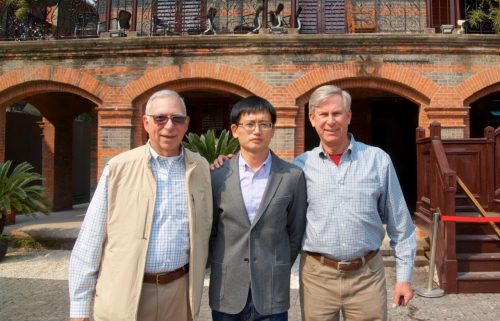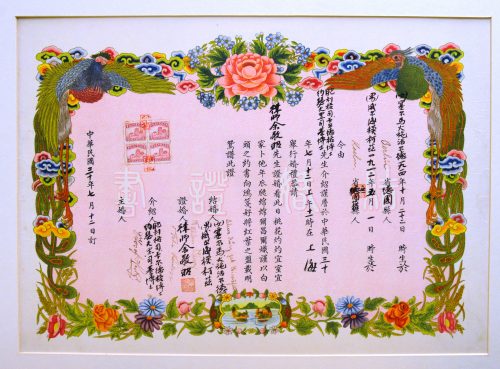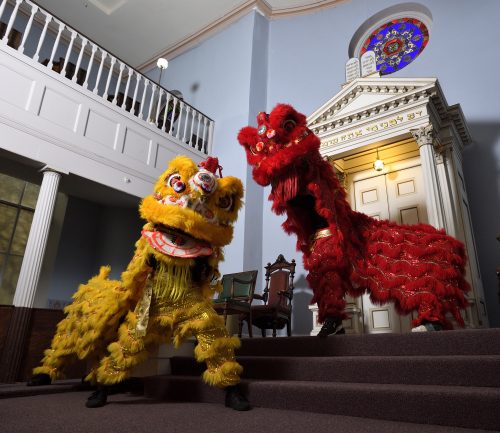With a Single Step

A blog post by JMM Executive Director Marvin Pinkert. You can read more posts by Marvin here.
A journey of 1,000 miles begins with a single step – Lao Tzu*, c. 550 BCE
Every exhibit at JMM is a journey. Many, like last year’s Just Married!,v are journeys through time set in our own backyard here in Maryland. A few, our current exhibit Inescapable: The Life and Legacy of Harry Houdini, is an example, travel across the globe as well. But no matter how deep or how far the journey they all, following the Taoist proverb begin with a single step.
Sometimes that step occurs within the walls of our museum – like finding an unusual object in our collection. Sometimes it seems to be serendipity (besheret) – for example, my encounter with magician David London while escaping the heat at Artscape.

Two JMM Board members (Duke Zimmerman and Abe Kronsberg) on a tour of China stepped into the former Ohel Moshe synagogue in Shanghai which has been converted into the Shanghai Jewish Refugees Museum and started a conversation with the Museum’s director James Yang. Their meeting let to an e-mail and that e-mail led to an agreement and just fourteen months later JMM will host the Maryland premiere of Jewish Refugees and Shanghai, a panel exhibition of photos and facsimiles with bilingual text in English and Mandarin.
My personal interest in the Shanghai story began years ago when I read Rabbi Marvin Tokayer’s Fugu Plan, the story of the Lithuanian refugees saved by Consul Sugihara and their difficult passage across Russia to Kobe, Japan and eventually to Shanghai. I knew that they were a small part of a much larger refugee community in Shanghai during the Holocaust, but I frankly lacked an appreciation for just how much larger (more than 20,000 Jewish residents) and how much longer (1937 to 1948) this refugee community survived.
Shanghai, today by far the largest city in the world, was a relatively small town into the early 1800s. The Treaty of Nanking (1842) imposed by the British at the end of the First Opium War had the effect of making Shanghai an open port – a place where East met West. It also encouraged the first Jewish settlers here, Baghdadi merchant families, like the Sassoons and the Kadoories, who made the city a base for their East Asian operations. A second wave of Jewish settlement came between 1903 and the mid-1920s and Jews fled the pogroms of Russia and later political uncertainty of the Soviet Union for new lives in Harbin and Shanghai.

The exhibit not only explains the history of the community as a whole, but also devotes considerable attention to individual stories, of both the famous and unheralded residents. There is a panel on the life of future US Treasury Secretary, W. Michael Blumenthal and one on artist Peter Max and his first Chinese art tutor. There are also stories of work life, weddings, and beauty contests – of help from Chinese neighbors and struggles to survive.

We began conversations with our docent, Rena Rotenberg (whose husband was in Shanghai) and Yvonne Daniels who was born in that community (and has since agreed to be a speaker in an upcoming program). We also discovered a number of fundraising scripts and posters used locally in the effort to support the community both before and after the war. These conversations and materials will form the basis of a small lobby exhibit on the Jews of Shanghai and Maryland that will be a companion piece to the main exhibit during its run from February 3 through March 10.

In subsequent weeks we will feature a half dozen lectures and films related to the Jewish experience in China – including two documentaries – Above the Drowning Sea and Minyan in Kaifeng (narrated by Leonard Nimoy, this is the unusual story of a 1,000 year-old Jewish community in central China).
Our Education department is also using this exhibit as a platform to expand our offerings. In conjunction with the Baltimore Jewish Council and the United States Holocaust Memorial Museum we are offering a “Winter Teacher’s Institute.” In this program, which parallels our annual summer institute, we will provide on-site and off-site workshops that will enable teachers across Maryland to incorporate the Shanghai story into their curricula. In another initiative, our educators have reached out to Chinese language programs at both the high school and college level, inviting them to take this rare opportunity to practice reading skills in Mandarin while learning about an important piece of history. Several schools and college programs have already scheduled field trips.
With these initiatives we will take thousands more of our visitors on a journey – that began with a single step.
*This is a loose translation of the quote which references a “1000 li”, a Chinese unit of measurement that in the sixth century BCE was actually closer to ¼ of a mile today – but it’s the same concept.
